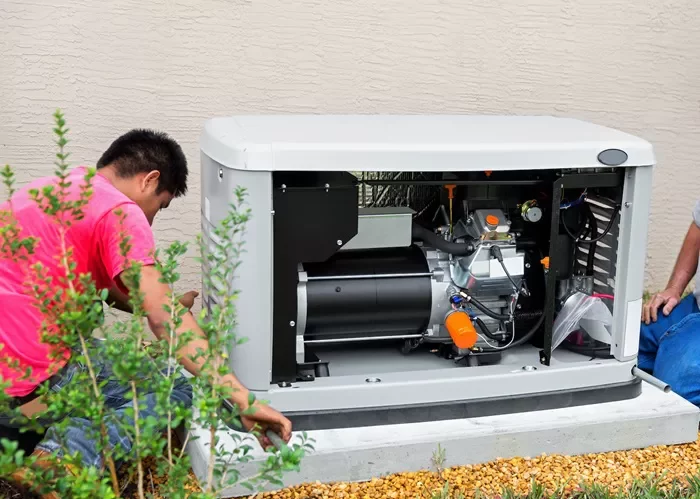Generators are essential backup power sources for homes during outages. Whether you’re preparing for emergencies or need temporary power, knowing how to operate a generator safely and efficiently is crucial. This guide covers everything from setup to maintenance, with clear explanations of electrical principles to help you use your generator like a pro.
Understanding Home Generators: Types & Key Components
Before operating a generator, it’s important to know the different types and how they work.
Types of Generators
Portable Generators: These are small, mobile units that run on gasoline, propane, or diesel. They provide temporary power and require manual startup.
Inverter Generators: A quieter, more fuel-efficient version of portable generators, ideal for sensitive electronics due to stable power output.
Standby Generators: Permanently installed units that automatically turn on during a power outage. They run on natural gas or propane and can power an entire home.
Key Generator Components
Engine: Powers the generator (measured in horsepower or kW).
Alternator: Converts mechanical energy into electrical energy.
Fuel System: Stores and supplies fuel (gas, diesel, or propane).
Voltage Regulator: Maintains consistent voltage output.
Cooling & Exhaust Systems: Prevent overheating and expel harmful gases.
Control Panel: Where you start/stop the generator and monitor power output.
Understanding these parts helps in troubleshooting and safe operation.
Pre-Operation Safety Checks
Safety should always come first when handling generators. Follow these steps before starting:
Location Setup
- Place the generator outdoors in a well-ventilated area, at least 20 feet away from windows and doors to prevent carbon monoxide poisoning.
- Ensure it’s on a dry, level surface to avoid tipping.
Fuel Inspection
- Use fresh fuel (old gasoline can clog the engine).
- Check for leaks in the fuel line or tank.
Oil & Battery Check
- Verify oil levels (low oil can damage the engine).
- If your generator has a battery, ensure it’s charged.
Load Calculation
- Add up the wattage of appliances you plan to power (e.g., fridge: 600W, lights: 100W).
- Never exceed the generator’s rated wattage (check the manufacturer’s label).
Starting & Running the Generator
Starting Procedure
- Turn off all connected appliances before starting.
- Switch the fuel valve to “ON.”
- Move the choke lever to “START” (if the engine is cold).
- Pull the recoil cord or press the electric start button.
- Once running, move the choke to “RUN.”
Connecting Appliances
Direct Plug-in: Use heavy-duty extension cords rated for outdoor use.
Transfer Switch: For standby generators, a licensed electrician should install a transfer switch to safely connect to your home’s electrical panel.
Never plug a generator directly into a wall outlet (backfeeding), as it can electrocute utility workers and damage your home’s wiring.
Monitoring Operation
- Check the voltage and frequency meters (standard home power is 120V/240V, 60Hz in the U.S.).
- Listen for irregular noises that may indicate mechanical issues.
- Avoid overloading—if the generator struggles, disconnect some devices.
Shutting Down the Generator Properly
- Turn off and unplug all appliances.
- Let the generator run for a few minutes to cool down.
- Switch the fuel valve to “OFF” to prevent carburetor clogs.
- Press the engine stop button or turn the ignition key to “OFF.”
Generator Maintenance for Longevity
Regular maintenance ensures reliability and extends the generator’s lifespan.
Oil and Filter Changes
- Change oil every 50-100 hours of use (check the manual).
- Replace air filters if dirty to maintain engine efficiency.
Fuel System Care
- Use fuel stabilizer if storing the generator for long periods.
- Drain old fuel before storage to prevent gumming.
Battery Maintenance (for Electric Start Models)
- Keep terminals clean and free of corrosion.
- Charge the battery every 3 months if unused.
Periodic Testing
- Run the generator for 15-30 minutes monthly to keep parts lubricated.
- Test under load (powering a few devices) to ensure proper function.
Conclusion
Operating a home generator safely requires understanding its components, performing pre-use checks, and following correct startup/shutdown procedures. Regular maintenance prevents breakdowns and ensures reliable backup power. By following this guide, you can confidently use your generator during outages while keeping your household safe.
For more complex installations (like standby generators), consult a licensed electrician to ensure compliance with local electrical codes. Stay prepared, and never be left in the dark!
This guide combines professional electrical knowledge with easy-to-follow steps, making it useful for both beginners and experienced users. Always refer to your generator’s manual for model-specific instructions.

